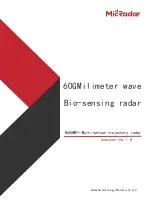
5-4
5300 ES Series Mobile Radio Operating Manual
Conventional Features
5.4.1
Call Guard Squelch Enable / Disable
The SEL SQ option switch (if programmed) can be used to disable receive Call Guard
squelch (Normal/Selective Squelch) on analog channels or group ID code detection on
P25 channels. When selective squelch is disabled, “SQ NORMAL” is flashed in the
display, and when it is enabled, “SQ SELECT” is flashed.
When “SQ NORMAL” is selected, the receiver unsquelches only if a carrier is detected.
Scanning and P25 NAC detection are not disabled with this mode selected. The selected
mode remains in effect until it is manually changed. Selecting another channel or cycling
power does not reselect a default condition. There is a programmable option to display
“MON” when the “SQ NORMAL” mode is selected.
5.4.2
Tone Call Guard Squelch
Tone-type Call Guard squelch uses subaudible CTCSS tones from 67-254.1 Hz. Although
there are 42 tones assigned, those above 33 (210.7 Hz) are normally not used because of
their close proximity to the voice band which starts at 300 Hz. In addition, tones 11 (97.4
Hz), 39 (69.3 Hz), 40 (206.5 Hz), 41 229.1 Hz), and 42 (254.1 Hz) are normally not used
because they may cause interference with adjacent tones.
A reverse burst is transmitted when the push-to-talk switch is released and also detected
when calls are received. It is a 180-degree phase reversal for a period of time determined
by the tone frequency, and it eliminates the squelch tail (noise burst) in the receiving radio.
Both the transmitting and receiving radio must be equipped with this feature for it to be
used. PC Configure can be used to turn OFF the reverse burst feature so that the squelch
tail is not eliminated.
5.4.3
Digital Call Guard Squelch
Digitally Coded Squelch (DCS) uses digital data instead of subaudible tones to control the
squelch. This data consists of continuous repetitions of 23-bit words. No bit or word
synchronization information is used. When the push-to-talk switch is released, a turn-off
code is transmitted which eliminates the squelch tail similar to the reverse burst.
Although there are thousands of possible code combinations with 23 bits, only 83 are
unique with the data scheme used. The number specified when the code is programmed is
actually a seed for a special algorithm used to generate the 23-bit data word. The data is
transmitted at a rate of 134.4 bits per second. Therefore, approximately six words are
transmitted each second. When the data is decoded, 23-bit samples are taken and then the
bits are rotated to determine if a valid code was received.
Содержание 5300 ES Series
Страница 2: ......
Страница 4: ......
Страница 12: ...viii 5300 ES Series Mobile Radio Operating Manual March 2008 List of Figures continued Figure Page ...
Страница 14: ...x 5300 ES Series Mobile Radio Operating Manual March 2008 List of Tables continued Table Page ...
Страница 52: ...4 14 5300 ES Series Mobile Radio Operating Manual March 2008 Radio Wide Features ...
Страница 100: ...6 22 5300 ES Series Mobile Radio Operating Manual March 2008 SMARTNET SmartZone P25 Trunked Features ...
Страница 110: ...7 10 5300 ES Series Mobile Radio Operating Manual March 2008 ...
Страница 116: ...9 4 5300 ES Series Mobile Radio Operating Manual March 2008 Password Description ...
















































